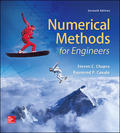
EBK NUMERICAL METHODS FOR ENGINEERS
7th Edition
ISBN: 8220100254147
Author: Chapra
Publisher: MCG
expand_more
expand_more
format_list_bulleted
Question
Chapter 28, Problem 21P
To determine
To calculate: The all diffusive mixing rate by using the Euler’s method with size of step
Expert Solution & Answer
Want to see the full answer?
Check out a sample textbook solution
Chapter 28 Solutions
EBK NUMERICAL METHODS FOR ENGINEERS
Ch. 28 - 8.1 Perform the first computation in Sec. 28.1,...Ch. 28 - 28.2 Perform the second computation in Sec. 28.1,...Ch. 28 - A mass balance for a chemical in a completely...Ch. 28 - 28.4 If, calculate the outflow concentration of a...Ch. 28 - 28.5 Seawater with a concentration of 8000 g/m3...Ch. 28 - 28.6 A spherical ice cube (an “ice sphere”) that...Ch. 28 - The following equations define the concentrations...Ch. 28 - 28.8 Compound A diffuses through a 4-cm-long tube...Ch. 28 - In the investigation of a homicide or accidental...Ch. 28 - The reaction AB takes place in two reactors in...
Ch. 28 - An on is other malbatchre actor can be described...Ch. 28 - The following system is a classic example of stiff...Ch. 28 - 28.13 A biofilm with a thickness grows on the...Ch. 28 - 28.14 The following differential equation...Ch. 28 - Prob. 15PCh. 28 - 28.16 Bacteria growing in a batch reactor utilize...Ch. 28 - 28.17 Perform the same computation for the...Ch. 28 - Perform the same computation for the Lorenz...Ch. 28 - The following equation can be used to model the...Ch. 28 - Perform the same computation as in Prob. 28.19,...Ch. 28 - 28.21 An environmental engineer is interested in...Ch. 28 - 28.22 Population-growth dynamics are important in...Ch. 28 - 28.23 Although the model in Prob. 28.22 works...Ch. 28 - 28.25 A cable is hanging from two supports at A...Ch. 28 - 28.26 The basic differential equation of the...Ch. 28 - 28.27 The basic differential equation of the...Ch. 28 - A pond drains through a pipe, as shown in Fig....Ch. 28 - 28.29 Engineers and scientists use mass-spring...Ch. 28 - Under a number of simplifying assumptions, the...Ch. 28 - 28.31 In Prob. 28.30, a linearized groundwater...Ch. 28 - The Lotka-Volterra equations described in Sec....Ch. 28 - The growth of floating, unicellular algae below a...Ch. 28 - 28.34 The following ODEs have been proposed as a...Ch. 28 - 28.35 Perform the same computation as in the first...Ch. 28 - Solve the ODE in the first part of Sec. 8.3 from...Ch. 28 - 28.37 For a simple RL circuit, Kirchhoff’s voltage...Ch. 28 - In contrast to Prob. 28.37, real resistors may not...Ch. 28 - 28.39 Develop an eigenvalue problem for an LC...Ch. 28 - 28.40 Just as Fourier’s law and the heat balance...Ch. 28 - 28.41 Perform the same computation as in Sec....Ch. 28 - 28.42 The rate of cooling of a body can be...Ch. 28 - The rate of heat flow (conduction) between two...Ch. 28 - Repeat the falling parachutist problem (Example...Ch. 28 - 28.45 Suppose that, after falling for 13 s, the...Ch. 28 - 28.46 The following ordinary differential equation...Ch. 28 - 28.47 A forced damped spring-mass system (Fig....Ch. 28 - 28.48 The temperature distribution in a tapered...Ch. 28 - 28.49 The dynamics of a forced spring-mass-damper...Ch. 28 - The differential equation for the velocity of a...Ch. 28 - 28.51 Two masses are attached to a wall by linear...
Knowledge Booster
Learn more about
Need a deep-dive on the concept behind this application? Look no further. Learn more about this topic, mechanical-engineering and related others by exploring similar questions and additional content below.Recommended textbooks for you
 Elements Of ElectromagneticsMechanical EngineeringISBN:9780190698614Author:Sadiku, Matthew N. O.Publisher:Oxford University Press
Elements Of ElectromagneticsMechanical EngineeringISBN:9780190698614Author:Sadiku, Matthew N. O.Publisher:Oxford University Press Mechanics of Materials (10th Edition)Mechanical EngineeringISBN:9780134319650Author:Russell C. HibbelerPublisher:PEARSON
Mechanics of Materials (10th Edition)Mechanical EngineeringISBN:9780134319650Author:Russell C. HibbelerPublisher:PEARSON Thermodynamics: An Engineering ApproachMechanical EngineeringISBN:9781259822674Author:Yunus A. Cengel Dr., Michael A. BolesPublisher:McGraw-Hill Education
Thermodynamics: An Engineering ApproachMechanical EngineeringISBN:9781259822674Author:Yunus A. Cengel Dr., Michael A. BolesPublisher:McGraw-Hill Education Control Systems EngineeringMechanical EngineeringISBN:9781118170519Author:Norman S. NisePublisher:WILEY
Control Systems EngineeringMechanical EngineeringISBN:9781118170519Author:Norman S. NisePublisher:WILEY Mechanics of Materials (MindTap Course List)Mechanical EngineeringISBN:9781337093347Author:Barry J. Goodno, James M. GerePublisher:Cengage Learning
Mechanics of Materials (MindTap Course List)Mechanical EngineeringISBN:9781337093347Author:Barry J. Goodno, James M. GerePublisher:Cengage Learning Engineering Mechanics: StaticsMechanical EngineeringISBN:9781118807330Author:James L. Meriam, L. G. Kraige, J. N. BoltonPublisher:WILEY
Engineering Mechanics: StaticsMechanical EngineeringISBN:9781118807330Author:James L. Meriam, L. G. Kraige, J. N. BoltonPublisher:WILEY

Elements Of Electromagnetics
Mechanical Engineering
ISBN:9780190698614
Author:Sadiku, Matthew N. O.
Publisher:Oxford University Press

Mechanics of Materials (10th Edition)
Mechanical Engineering
ISBN:9780134319650
Author:Russell C. Hibbeler
Publisher:PEARSON

Thermodynamics: An Engineering Approach
Mechanical Engineering
ISBN:9781259822674
Author:Yunus A. Cengel Dr., Michael A. Boles
Publisher:McGraw-Hill Education

Control Systems Engineering
Mechanical Engineering
ISBN:9781118170519
Author:Norman S. Nise
Publisher:WILEY

Mechanics of Materials (MindTap Course List)
Mechanical Engineering
ISBN:9781337093347
Author:Barry J. Goodno, James M. Gere
Publisher:Cengage Learning

Engineering Mechanics: Statics
Mechanical Engineering
ISBN:9781118807330
Author:James L. Meriam, L. G. Kraige, J. N. Bolton
Publisher:WILEY
Introduction to experimental design and analysis of variance (ANOVA); Author: Dr. Bharatendra Rai;https://www.youtube.com/watch?v=vSFo1MwLoxU;License: Standard YouTube License, CC-BY